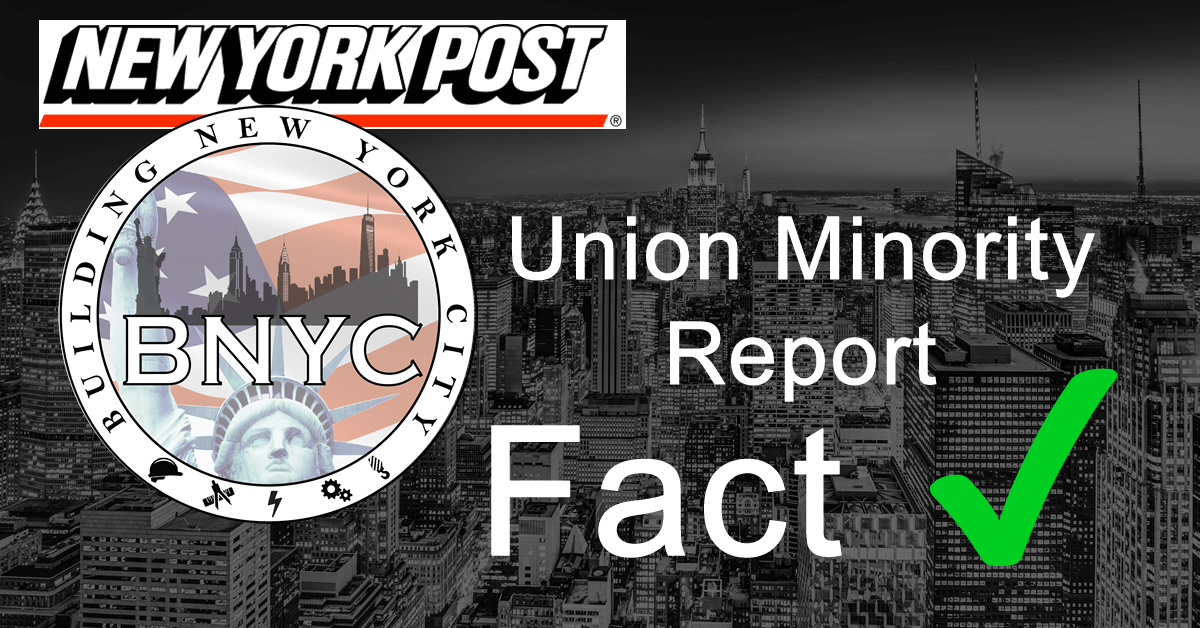From The New York Post:
By Richard Berman
When Averil Morrison sued the International Union of Operating Engineers Local 14-B for racial discrimination back in 2012, she confirmed what we’ve known for decades: New York City union construction is no standard-bearer for workplace diversity.
And when her lawsuit received a pre-trial hearing this month, the plight of minority employees citywide gained renewed relevance.
Operating Engineers Local 14 “intentionally and systematically discriminated in favor of white members in the assignment of work to operating engineers,” according to a summary of the complaint. The union allegedly “prevents many minorities from joining the union while welcoming whites . . . referred or sponsored by existing white members.” (Translation: It’s who you know that counts.)
According to the complaint, Local 14-B’s membership is 91 percent white — only about 100 of its roughly 1,200 members are minorities.
Unsettling, yes, but not surprising. City construction unions’ history of racial discrimination prompted an investigation by the New York City Commission on Human Rights under former Mayor David Dinkins. In 1993, the commission issued a damning “Building Barriers” report, which found that the severe underrepresentation of black employees indicated a “profound failure in social policy.”
Two decades later, it seems little has changed. Building and Construction Trades Council of Greater New York President Gary LaBarbera claims that collective bargaining is the “great equalizer” when it comes to job opportunities and pay for all races and ethnicities.
That’s not what the data suggest: In New York City, Census Bureau numbers found that black union workers make $5.74 less per hour on average than their white counterparts — or 20 percent less. At full time, that’s a difference of $11,500 a year.
How do you reconcile the rhetoric of the BCTC with the hard data from the Census Bureau? Easy: Construction unions appear to prevent minority workers from getting the best-paid gigs. Local 14-B, for example, allegedly allows its predominantly white membership to refer new prospective members (who are also mostly white) as full “journeymen,” while requiring prospective members without connections (who are mostly non-white) to accept lower-paid apprenticeships.
These new journeymen essentially skip apprenticeship even if they don’t have “any qualifications other than being sponsored by an existing [white] member.”
This brings to mind the Dinkins report, which found that “white male workers routinely become union members after working at a job site for one to four weeks, while minorities often spend four or five years in an apprenticeship program.”
Not only are black employees earning less for their work — journeymen can earn as much as $35 an hour more than apprentices — but they’re often forced to play a half-decade-long game of catch-up.
Today’s construction unions may argue that they’ve made progress, but the 21-member executive board of the BCTC is still (to quote former SEIU boss Andy Stern) male, pale and stale. An ongoing Center for Union Facts campaign, which features a Times Square billboard and full-page newspaper ads, draws attention to this injustice.
So does the state NAACP, which criticized the Building and Construction Trades Council for “claiming that union construction is more racially integrated than it actually is.”
Confronted with these facts, the Building and Construction Trades Council has done its best to change the subject.
And some of their allies in the media are complicit. When my organization asked to run an advertisement in City and State exposing constructions unions’ diversity issues, publisher Tom Allen refused, with his spokesperson citing the fact that the unions are their clients.
City and State later followed up this favor by providing LaBarbera with a “safe space” on TV to criticize our campaign without being asked tough questions about the racial pay gap.
The real loser in all of this is New York’s minority community, still barred from climbing the ladder of opportunity. Big Labor has built the city some spectacular skyscrapers over the years. But it seems to be building racial barriers at the same time.
Richard Berman is the executive director at the Center for Union Facts.
Read more from The New York Post…
This post is also available in: Spanish, Russian, Polish, Chinese (Simplified)






